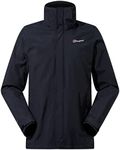Buying Guide for the Best Waterproof Jackets For Men
When choosing a waterproof jacket, it's important to consider the conditions you'll be facing and the activities you'll be engaging in. A good waterproof jacket should keep you dry, comfortable, and protected from the elements. Consider factors such as breathability, durability, and fit to ensure you select a jacket that meets your needs. Understanding the key specifications will help you make an informed decision.Waterproof RatingThe waterproof rating of a jacket indicates how well it can withstand water pressure without leaking. This is usually measured in millimeters (mm) and refers to the amount of water a fabric can handle before it starts to leak. Ratings typically range from 5,000mm to 20,000mm or more. For light rain or short periods of exposure, a lower rating (5,000-10,000mm) may suffice. For heavy rain or prolonged exposure, look for a higher rating (15,000mm and above). Consider your typical weather conditions and choose a rating that will keep you dry in those scenarios.
BreathabilityBreathability refers to how well a jacket allows moisture from sweat to escape, keeping you dry and comfortable inside. It's often measured in grams (g) and indicates how much moisture can pass through the fabric in a 24-hour period. Ratings can range from 5,000g to 20,000g or more. If you're engaging in high-intensity activities like hiking or running, opt for a jacket with higher breathability (10,000g and above) to prevent overheating. For less strenuous activities, a lower breathability rating may be sufficient.
Fabric TypeThe type of fabric used in a waterproof jacket affects its durability, weight, and feel. Common materials include Gore-Tex, eVent, and proprietary fabrics from various brands. Gore-Tex is known for its excellent waterproofing and breathability, making it a popular choice for outdoor enthusiasts. eVent offers similar performance with a focus on breathability. Consider the balance between durability and weight; heavier fabrics are often more durable but less packable, while lighter fabrics are easier to carry but may not withstand rough conditions as well.
Seam SealingSeam sealing is a process that involves taping or welding the seams of a jacket to prevent water from seeping through the stitching. Fully taped seams offer the best protection against water ingress, while critically taped seams only cover the most vulnerable areas. If you expect to be in heavy rain or wet conditions, look for a jacket with fully taped seams. For less demanding conditions, critically taped seams may be adequate.
Fit and AdjustabilityThe fit of a waterproof jacket affects comfort and performance. A well-fitting jacket should allow for a full range of motion without being too tight or too loose. Consider the type of layering you plan to wear underneath and choose a size that accommodates it. Adjustability features like drawcords, Velcro cuffs, and adjustable hoods can help customize the fit and improve protection against the elements. Think about your typical activities and choose a fit that allows for ease of movement and comfort.
Hood DesignThe hood design of a waterproof jacket is crucial for protecting your head and face from rain and wind. Look for a hood that is adjustable and can be cinched down to prevent it from blowing off in strong winds. Some hoods are helmet-compatible, which is important if you plan to wear a helmet for activities like climbing or cycling. Consider whether you need a stowable hood that can be tucked away when not in use, or a fixed hood for consistent protection.















